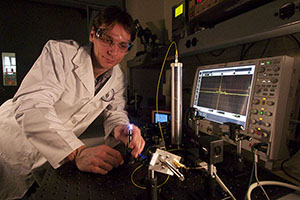main content begins
For decades, astronomers have been attempting to answer one of the biggest questions in all of science: Is there intelligent life beyond the Earth?
In 1960, the search for extraterrestrial intelligence (SETI) began when astronomer Frank Drake scanned the skies with a radio telescope in an attempt to detect a signal from an alien civilization. Many other SETI programs followed Drake’s lead, targeting different “phase spaces” defined by different radio frequencies, signal sensitivities and regions of the sky.
At around the same time that Drake was conducting his program, astronomers were also exploring the feasibility of signaling or detecting an ETI with an optical signal. But building an optical transmitter of sufficient power or a receiver able to detect such a signal was beyond 1960s technology.
As SETI continued in the radio realm, laser technology advanced to the point where it was possible to build optical transmitters powerful enough to send a signal detectable at astronomical distances. A pulse from a 1015 watt laser, in the range of a nanosecond in duration and beamed with a 10-metre telescope, would outshine our Sun by a factor of 3000—if only for the length of the brief pulse.
In recent decades, various teams have commenced optical SETI (OSETI) programs designed to detect such a signal. The Lick OSETI survey—conducted between 2001 and 2006—observed 4600 stars within 200 light-years of Earth, including stars with known planets. In 2011/2012, the same group observed stars identified by the Kepler space telescope as having three or more exoplanets or candidate-planets.
Today, advances in telecommunications and remote-sensing technologies like LIDAR (Light Detection and Ranging) have opened up a new SETI realm. With developments in near-infrared photomultiplier tubes (PMT) and Avalanche Photo Diodes (APDs), it is now possible to build an OSETI detector for an unexplored phase-space: nanosecond signals in the near-infrared.
Near-infrared Optical SETI (NIROSETI) has the advantage that light at infrared wavelengths is less affected by interstellar gas and dust; an infrared signal can be seen at greater distances than an optical signal at shorter wavelengths. Also, it takes less energy to send the same amount of information with an infrared signal than at shorter, optical wavelengths.
Prof. Shelley Wright, formerly of the Dunlap, leads the team that built the NIROSETI instrument and is developing a search strategy for a survey that will commence in 2015. At the Dunlap, the team includes Dunlap Fellow Jérome Maire and graduate student Elliot Meyer. The instrument achieved first-light on PI Day, 14 March 2015.

Jérome Maire tests a detector for the NIROSETI instrument in the Dunlap’s Optical-Infrared Lab.
At the Dunlap Institute:
NIROSETI Collaborators:
Shelley Wright (UC San Diego)
Frank Drake (SETI Institute)
Geoff Marcy (Berkeley)
Andrew Siemion (Berkeley)
Remington Stone (UCOLick)
Richard Treffers (Starman Systems)
Dan Werthimer (SSL/Berkeley)